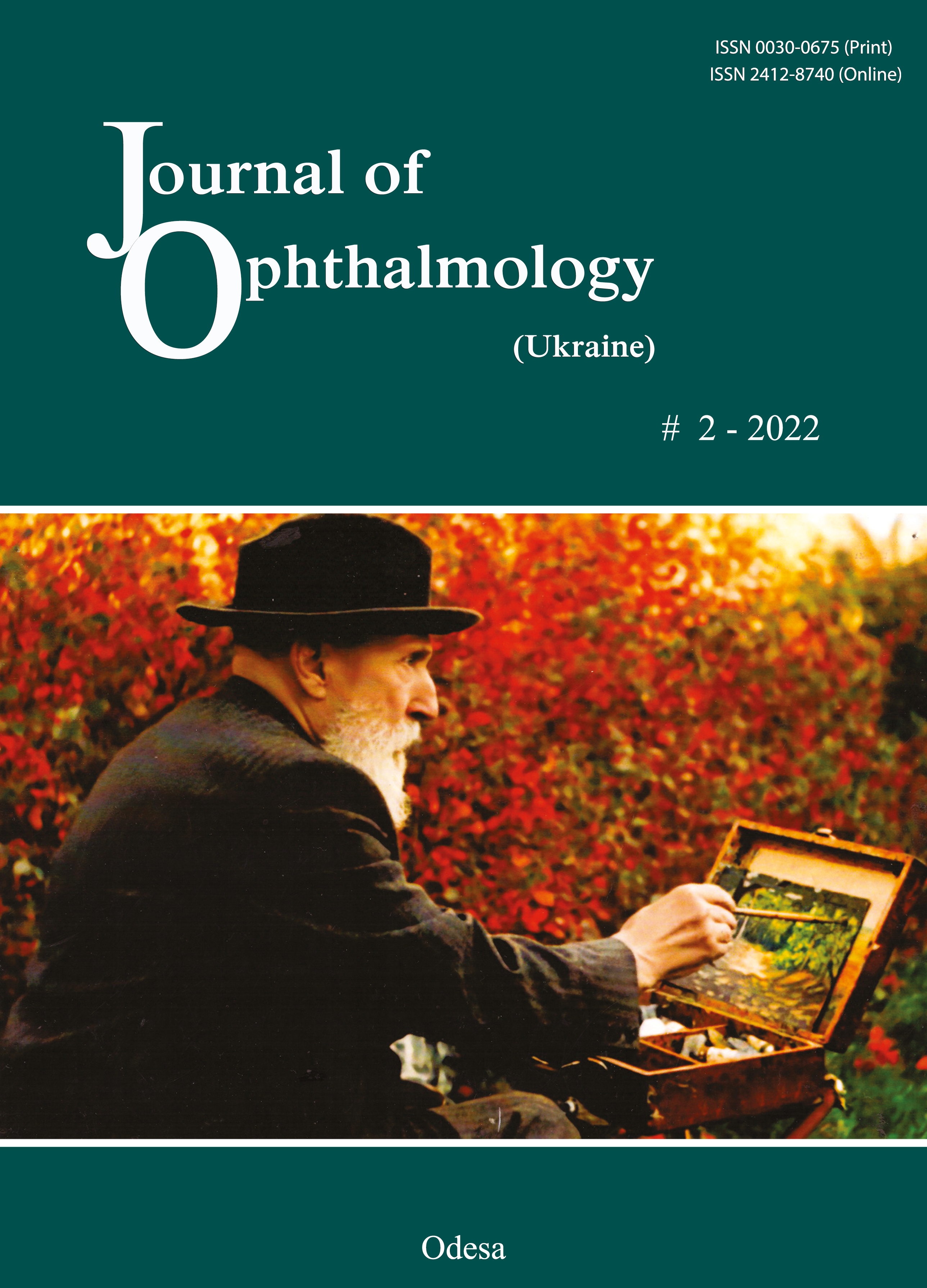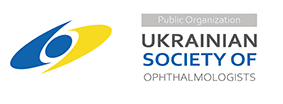Morphological and functional changes in the rabbit iris and ciliary body in experimental hypopinealism
DOI:
https://doi.org/10.31288/oftalmolzh202224247Keywords:
ciliary body, iris, around-the-clock illumination, hypopinealism, melatonin, morphological and functional changesAbstract
Background: Previous morphological studies have found degenerative retinal abnormalities in experimental hypopinealism. It is important to determine the morphology and function of the iris and ciliary body in prolonged pineal gland dysfunction with melatonin deficiency.
Purpose: To determine the morphology and function of the iris and ciliary body in rabbits maintained under conditions of prolonged around-the-clock illumination leading to hypopinealism and melatonin deficiency.
Material and Methods: Fifty five adult rabbits (110 eyes) were used in this experimental study. Animals were divided into two groups, an experimental group of 32 animals maintained under conditions of around-the-clock illumination to induce functional hypopinealism, and a control group of 23 animals maintained under natural day/night cycle conditions. Both groups were subdivided into 5 subgroups based on the duration of the experiment: 1-2 months, 3-5 months, 8-12 months, 18-19 months, and) 26-28 months. Blood melatonin levels were assessed by an enzyme-linked immunosorbent assay. A comprehensive morphological study of rabbit iris and ciliary body specimens was conducted.
Results. Blood melatonin level at night time in the experimental group was almost six-fold lower than blood melatonin level in the control group. In animals maintained under conditions of around-the-clock illumination, marked circulatory abnormalities with markedly dilated and hyperemic vessels were observed in the iris and ciliary body at time points until 12 months. In addition, at 12 to 28 months, iris and ciliary body vascular circulatory abnormalities appeared to be changed by sclerotic abnormalities. In animals exposed to around-the-clock illumination, vascular sclerotic changes appeared substantially earlier, and were much more marked, than in control animals. The mean vascular wall thickness (VWT) in iris and ciliary body specimens for the experimental group was 1.5-fold higher than that for the control group (177.5 ± 7.3×10-6 m vs 101.9 ± 4.4×10-6; р < 0.05) at 18 to 19 months, and twice higher than that for the control group (217.4 ± 8.7×10-6 m vs 107.2 ± 5.2 ×10-6 m) at 26 to 28 months. The like newly formed rough bundles of collagen fibers found in an analogue of the Schlemm canal may exert a very negative effect on hydrodynamics of the eye.
References
1.Brainard GC, Hanifin JP, Greeson JM, et al. Action spectrum for melatonin regulation in humans: evidence for a novel circadian photoreceptor. J Neurosci. 2001 Aug 15;21(16):6405-12. https://doi.org/10.1523/JNEUROSCI.21-16-06405.2001
2.Gooley JJ , Rajaratnam SM, Brainard GC, et al. Spectral responses of the human circadian system depend on the irradiance and duration of exposure to light. Sci Transl Med. 2010 May 12;2(31):31ra33. https://doi.org/10.1126/scitranslmed.3000741
3.Korf HW, Schomerus C, Stehle JH. The pineal organ, its hormone melatonin, and the photoneuroendocrine system. Adv Anat Embryol Cell Biol. 1998; 146:1-100. https://doi.org/10.1007/978-3-642-58932-4_1
4.Moore RY. Organization and function of a central nervous system circadian oscillator: the suprachiasmatic hypothalamic nucleus. Fed Proc. 1983 Aug;42(11):2783-9.
5.Ruby NF, Brennan TJ, Xie X, et al. Role of melanopsin in circadian responses to light. Science. 2002 Dec 13;298(5601):2211-3. https://doi.org/10.1126/science.1076701
6.Wetterberg L. Light and biological rhythms. J Intern Med. 1994 Jan;235(1):5-19. https://doi.org/10.1111/j.1365-2796.1994.tb01027.x
7.Bondarenko LA, Gubina-Vakulik GI, Sotnik NN. [Effects of constant light on the rabbit's circadian melatonin rhythm and pineal gland structures]. Problemy endocrinnoi patologii. 2005;4:38-45. Russian.
8.Gubina-Vakulik GI, Bondarenko LA, Sotnik NN. [Prolonged around-the-clock illumination as a factor of accelerated aging of the pineal gland]. Uspekhi gerontologii. 2007; 20(1): 92-5. Russian.
9.Alkozi HA, Wang X, Perez de Lara M, Pintor J. Presence of melanopsin in human crystalline lens epithelial cells and its role in melatonin synthesis. Exp Eye Res. 2017; 154:168-76. https://doi.org/10.1016/j.exer.2016.11.019
10.Cahill GM, Besharse JC. Light‐sensitive melatonin synthesis by Xenopus photoreceptors after destruction of the inner retina. Vis Neurosci. 1992; 8: 487-90. https://doi.org/10.1017/S0952523800005009
11.Hamm HE, Menaker M. Retinal rhythms in chicks: circadian variation in melatonin and serotonin N‐acetyltransferase activity. Proc Natl Acad Sci USA. 1980 Aug;77(8):4998-5002. https://doi.org/10.1073/pnas.77.8.4998
12.Iuvone PM, Tosini G, Pozdeyev N, et al. Circadian clocks, clock networks, arylalkylamine N‐acetyltransferase, and melatonin in the retina. Prog Retin Eye Res. 2005; 2005 Jul;24(4):433-56. https://doi.org/10.1016/j.preteyeres.2005.01.003
13.Martin XD, Malina HZ, Brennan MC, et al. The ciliary body - the third organ found to synthesize indoleamines in humans. Eur J Ophthalmol. 1992;2:67-72.
https://doi.org/10.1177/112067219200200203
14.Pescosolido N, Gatto V, Stefanucci A, Rusciano D. Oral treatment with the melatonin agonist agomelatine lowers the intraocular pressure of glaucoma patients. Ophthalmic Physiol Opt. 2015 Mar;35(2):201-5. https://doi.org/10.1111/opo.12189
15.Nedzvetskaya OV, Kolot AV, Bondarenko LA. [Investigating retinal morphological changes in experimental hypopinealism]. Oftalmologiiaa. Vostochnaia Evropa. 2015; 2 (25): 35-40. Russian.
16.Matviienko AV, Stepanova LV. [Guidelines on preclinical morphological studies in preclinical medication trials]. Kyiv: State Pharmacological Center at the Ministry of Health of Ukraine; 2001. Ukrainian.
17.Lillie RD. [Histopathologic technic and practical histochemistry]. Moscow: Mir; 1969. Russian.
18.Sarkisov DS, Perova IuL, editors. [Microscopic technique: a manual]. Moscow: Meditsina; 1996. Russian.
19.Lapach SN, Chubenko AV, Babich PN. [Statistical methods in medical and biological studies using Excel]. 2nd ed. Kyiv: Morion; 2007. Russian.
20.Avtandilov G.G. [Basics of quantitative pathological anatomy]. Moscow: Meditsina; 2002. Russian.
21.Sergiienko VI., Bondareva IB. [Mathematical statistics in clinical studies] Moscow: Geotar Meditsina; 2000. Russian.
22.Lemaigre-Voreaux P. Melatonine et Lumiere. Lux. 1986; 139:183-97.
Downloads
Published
How to Cite
Issue
Section
License
Copyright (c) 2025 О. В. Недзвецкая, У. А. Пастух, Е. В. Кихтенко, И. В. Пастух, Н. Н. Сотник, Н. А. Гончарова, О. В. Кузьмина де Гутарра

This work is licensed under a Creative Commons Attribution 4.0 International License.
This work is licensed under a Creative Commons Attribution 4.0 International (CC BY 4.0) that allows users to read, download, copy, distribute, print, search, or link to the full texts of the articles, or use them for any other lawful purpose, without asking prior permission from the publisher or the author as long as they cite the source.
COPYRIGHT NOTICE
Authors who publish in this journal agree to the following terms:
- Authors hold copyright immediately after publication of their works and retain publishing rights without any restrictions.
- The copyright commencement date complies the publication date of the issue, where the article is included in.
DEPOSIT POLICY
- Authors are permitted and encouraged to post their work online (e.g., in institutional repositories or on their website) during the editorial process, as it can lead to productive exchanges, as well as earlier and greater citation of published work.
- Authors are able to enter into separate, additional contractual arrangements for the non-exclusive distribution of the journal's published version of the work with an acknowledgement of its initial publication in this journal.
- Post-print (post-refereeing manuscript version) and publisher's PDF-version self-archiving is allowed.
- Archiving the pre-print (pre-refereeing manuscript version) not allowed.












